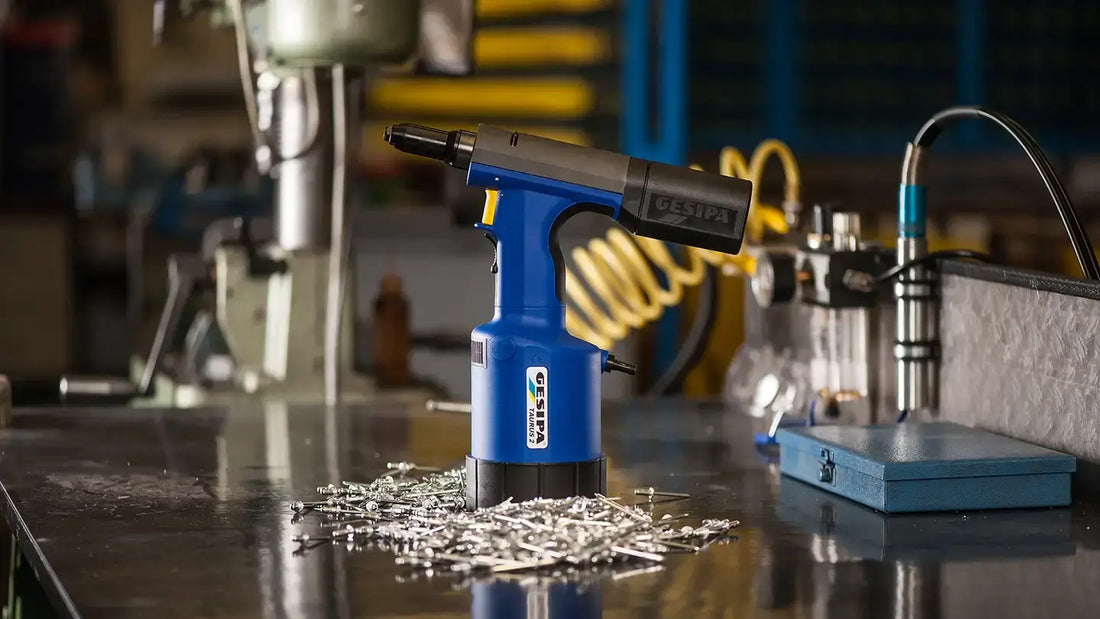Air rivet guns are useful tools in many industries. They help fasten and join materials together. This is important for production, construction, and maintenance work. Compared with cordless rivet guns or manual rivet tools, air-powered rivet guns provide superior traction power and rapid installation, making them particularly well-suited for handling large-diameter rivet installation.
Some air rivet guns use only air power. However, most modern models use air-hydraulic systems. These systems include a hydraulic part in the rivet setting process.
This is how a pneumatic rivet gun works:
When the trigger of the air rivet gun is activated, compressed air is released. The high-pressure air forces a piston inside the gun to move, creating pressure in a hydraulic oil chamber. This hydraulic oil serves as the medium for transmitting force throughout the system.
The hydraulic pressure activates the gun's jaw mechanism. This pulls the rivet mandrel and expands the rivet body, securing and clamping the materials that need joining.
Tips For Setting Up An Air Supply System
For an air-hydraulic rivet gun to work at its peak performance, it relies on a consistent compressed air supply. If the air supply is interrupted or poorly maintained, it can halt production or work. Here are a few tips for setting up an air supply correctly:
1. Compressor Size and Setup: The size and capacity of the compressor must match the tool’s requirements. Inadequate air pressure or volume can damage the tool or lead to suboptimal performance.
2. Use an Air Regulator: Always use an air regulator. Adjust the air pressure to the manufacturer’s instructions. A common operating air pressure is between 75 and 100psi. Install the air regulator at the operational site rather than the air compressor location, especially in expansive production spaces or large production lines with multiple air hoses feeding several air rivet guns, to prevent a drop in air pressure.
3. Use an Air Filter: Most air-hydraulic rivet guns are designed to operate on clean and dry compressed air. An air filter is recommended to remove contaminants and moisture in compressed air. Employing an air filter will substantially prolong the tool’s lifespan.
4. Air Lubricator: You may use an air lubricator to connect between your air source and the rivet gun. The air lubricator provides controlled lubrication to reduce friction and prevent overheating in moving parts like the piston. Nevertheless, it’s important to note that while beneficial, it’s not always necessary. Sometimes, it can be misused due to incorrect flow rate or excessive lubrication volume.
Here is a diagram that provides an overview of configuring the air supply system.

Air Rivet Gun Maintenance
Routine maintenance for an air rivet gun holds as much significance as setting up a reliable air supply system.
1. Lubrication: Instead of using an air lubricator, you may lubricate the tool by adding a few drops of standard air tool oil into the air inlet. We suggest performing this task daily. For your convenience, you can find air tool oil at tool stores and industrial suppliers.
2. Hydraulic Oil Maintenance: Follow the manufacturer’s instructions for maintaining the hydraulic oil level. Signs of low oil include difficulty installing rivets in one stroke or incomplete rivet insertion to the nosepiece. Please don’t mix the hydraulic oil with the air tool oil, as they serve different purposes. In our application, we use Castrol Hyspin AWH 32 hydraulic oil.
3. Frequent Cleaning: Regularly clean the jaws and nose areas. This helps prevent rivet swarf buildup and avoid jaw problems.
Air Rivet Gun Operations
To ensure the safe and effective use of your air rivet gun, consider the following:
1. Correct Nosepiece Selection: Always choose the right-sized nosepiece to match your rivets, ensuring a secure fit.
2. Secure Nosepiece: Before use, tightly secure the nosepiece with a spanner to prevent mishaps during operation.
3. Rivet Selection: Unlike an air nutsert gun, an air rivet gun lacks stroke adjustment capabilities. Therefore, to enhance job efficiency and install a rivet with a single trigger pull, selecting a rivet of the appropriate body length for the task at hand is essential.
4. Safety First: Safety is paramount. Equip the tool with a mandrel collector before operation, and empty it regularly to prevent jams. Wear eye protection and follow all manufacturer safety instructions.
5. Test Run: Always conduct a test run before high-production tasks.
If you encounter operational challenges or experience issues with your rivet gun, please remember that RivetLab is an Authorised Service Centre for FAR, GESIPA® and POP®. Don’t hesitate to reach out by phone or send your tool in for professional servicing and support.

